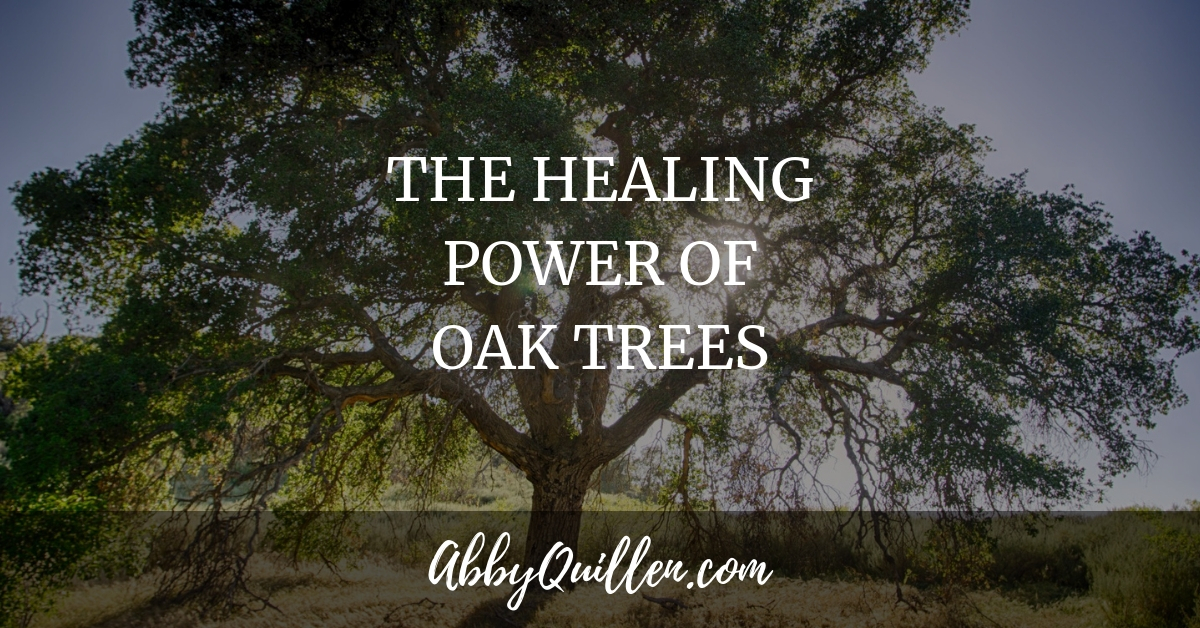The Healing Power of Oak Trees
Fifteen years ago, my husband and I stood under a massive, gnarled limb of an oak tree and said our vows to each other.
Oak trees are considered sacred by many cultures, but we didn’t know that then. Nor did we know they were traditionally used for spiritual and civic gatherings (like weddings) to offer strength and protection.
So we were fortunate fate brought us together beneath that majestic oak tree.
The oak tree is sometimes called the king of trees. About 400 species of oaks, including coniferous and deciduous species, grow in the northern hemisphere. There are 60 varieties of oaks native to the United States, and some live for up to a thousand years.
If you haven’t gotten to know an oak tree, it’s time you did. It may sound silly to get to know a tree, but remember, trees absorb and store our rainwater. They compost the ground to build healthy soil, which is essential to all life. They give us the oxygen we breathe. They’re the best allies we’ll ever have.
Humans and Oaks Helped Each Other
Sometimes my kids and I play a game called “Did a person make it or did nature?” My kids usually knew even when they were very young. A person made our Legos. Nature made bears. A person made Dad’s eyeglasses. Nature made our brains.
If I asked my kids who made the beautiful sprawling oak savanna near our house, they’d probably say it was nature. But the answer is more complicated than that. Native American people worked with nature to create Oregon’s oak savannas.
Oaks don’t grow well in the shade and can’t survive when Douglas Firs and Western Red Cedars crowd out the light. But they’re fire-resistant. So the Kalapuya and Chelis tribes set low-intensity fires to keep the conifers from growing in certain areas. The fires kept the Oregon White Oak and California Black Oak healthy and encouraged the growth of wildflowers, such as camas lilies, which Native tribes used for food.
In modern times, we’re rediscovering this ancient land management system. We’d also do well to learn from ancient food customs, starting with the humble but mighty acorn.

Acorns are an Heirloom Food
Acorns aren’t just for squirrels. They’ve been a staple food for people in North America, Asia, the Middle-East, North Africa, and Europe for thousands of years. The Roman philosopher Pliny the Elder said the sacred oak was the “tree which first produced food for mortal man.”
All acorns are edible, and they’re high in calories, fat, magnesium, calcium, phosphorus, and antioxidants. But unlike squirrels, you can’t enjoy acorns just off the tree. They’re bitter when eaten raw, and they require low-tech processing to make them palatable for humans.
Here’s how to turn acorns into a nutritious flour. Gather whole acorns from the ground and bake them at 250 degrees for a half hour to kill any bug larvae. Shell them using a nutcracker (or a high-quality nut sheller, if you plan to shell large quantities). To leach the bitterness from them, boil them for five to 10 minutes, pour off the murky water, and repeat the process five or six times until the acorns are palatable. Dehydrate the acorns on a tray in a sunny location or in a food dehydrator. Finally, grind the acorns into flour.
Does this process sound difficult? Remember, flours made from tillage crops, such as wheat and corn, also require a fair amount of processing. But acorns offer a major advantage. You don’t need to clear the land of trees and wildlife or use pesticides and herbicides to grow oak trees.
Agriculture is one of the leading causes of biodiversity loss. Farming is what threatens three quarters of the world’s endangered species. If we could take advantage of a nutritious staple food crop without agriculture, it would be a boon for threatened ecosystems.
Lincoln Smith, a gardener in Massachusetts, is experimenting with using acorns as food at Forested, his 10-acre research garden. On one occasion, Smith gleaned 1,000 pounds of acorns from the trees on his busy street in four days. He makes bread by mixing acorn flour one to one with wheat flour.
Acorn bread has a nutty taste and appealing hearty flavor, according to reporter Caroline Selle, who wrote about Smith for Civil Eats. Smith also makes baked chocolate and molasses acorn cookies, which are “sweet, rich, nutty, and good,” according to Selle.
Despite its potential merits, acorn flour isn’t readily available commercially. You can import it from Korea, where it’s commonly eaten, or pay a premium price from a small-scale producer. Otherwise, you’ll need to copy the squirrels and harvest and process your own.
Oak Medicine
Oak bark is an astringent, and it can be used to heal bleeding gums, sore throats, scrapes, or rashes. To make a decoction of it, cut a small branch off any oak tree. Soak it in water to clean it. Use a knife to remove the outer-most bark and discard it. Then shave off a tablespoon of the white inner bark and boil it in four cups of water for 20 minutes or more. Use it as a gargle, rinse, or compress.
Native Americans also used oak chewing sticks to clean their teeth. Unlike nylon toothbrush bristles, oak twigs are naturally antibacterial and antiseptic. In a study, nearly all (99.9 percent) of bacteria spread on various wooden cutting boards, including oak, were undetectable within three minutes.
That’s significant because toothbrushes harbor huge amounts of germs. Ten million bacteria, including fecal germs, live on the average toothbrush. Seventy percent of people’s toothbrushes are heavily contaminated with potentially pathogenic bacteria and viruses, such as Staphylococcus aureus, E. coli, Pseudomonas, and herpes simplex virus, according to a study.
Plus, unlike plastic toothbrushes, chewing sticks don’t pollute the environment by lingering in landfills for five hundred to a thousand years.
It’s easy to make an oak chewing stick. Remove a small twig from an oak tree, peel the bark off one end, and leave it in a glass of water overnight to soften it. The next day, chew on it until bristles form and use it to scrub your teeth as you would with a toothbrush, no toothpaste needed. Use the same chewing stick several times by breaking the bristles off and starting over again.
If you think this ancient technology sounds primitive (or even disgusting), consider the conclusion of a randomized clinical trial comparing chewing sticks to toothbrushes, which was published in the North American Journal of Medical Sciences in July 2014: “Chewing stick was found to be equally effective as toothbrush in terms of gingival status. On the other hand, chewing stick had shown even better results in terms of reduction in plaque scores than in subjects using toothbrush.”

Oaks Need Us
Now here’s the bad news. Oak ecosystems around the world are declining. Oaks once covered 50 percent of the Willamette Valley where I live, but their numbers have been reduced by 97 percent. Oaks are also disappearing from Minnesota and other states. A quarter of the oak trees in the U.S. are threatened.
Why are our oaks in decline? European settlers’ fear of fire helped transform sunny oak savannas into shady woodlands. Habitat destruction, pests and diseases, agriculture, and development are also culprits. But these are symptoms of the real problem. Now that we let the acorns rot on the ground and get our medicines from pharmaceutical companies, we’ve forgotten the value of oak trees.
Do trees matter? What do they do for us? Diana Beresford-Kroeger eloquently answers that question in her book The Global Forest.
Trees breathe, communicate, reproduce, filter pollution from the air, provide habitat for wildlife, flora and fauna, provide aesthetic value and beauty on the planet, absorb CO2 (greenhouse gas) and release life-sustaining oxygen (50% comes from trees and 50% comes from ocean plankton), provide shelter and provide a variety of food, such as fruit and nuts, as well as medicines. Trees connect elements of nature and we are connected to trees – we are one. Trees provide wind and erosion control, soil stability, assist in controlling the movement of water and in purifying groundwater. Trees provide branches for children’s swings, tree houses or for children to climb.”
Beresford-Kroeger goes on for several more pages about the virtues of trees. And even then, she can’t do them justice. They are — in a word — our lifeblood.
We need oaks and they need us. Enjoy their shade and beauty. Eat their food, and use their medicine. Fall in love with an oak tree. That’s how we’ll save them.
If you liked this post, you may enjoy these similar posts:



One Comment
Comments are closed.